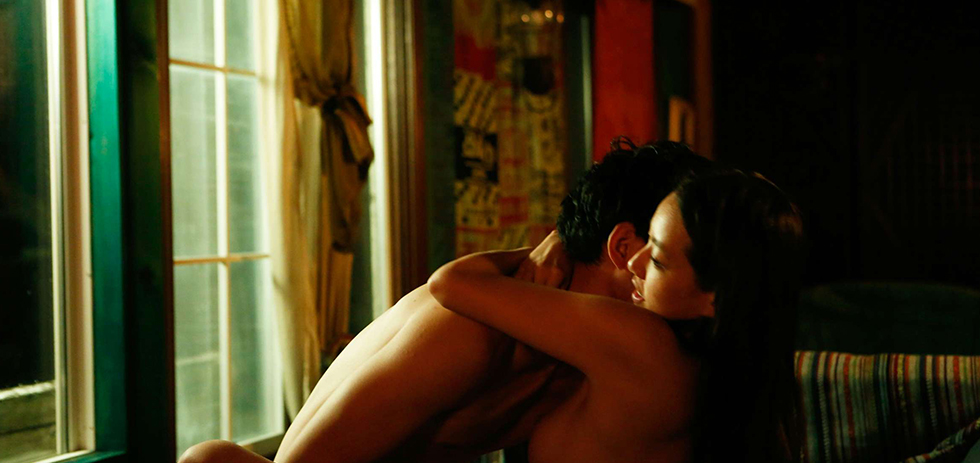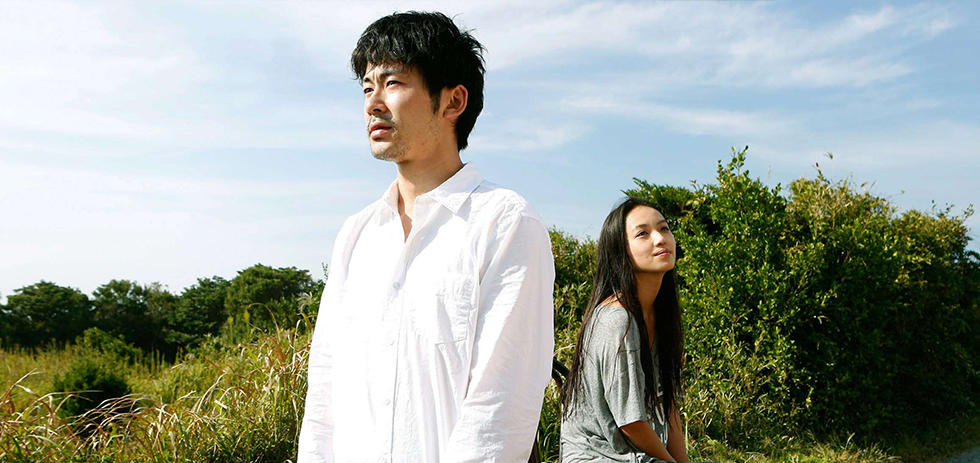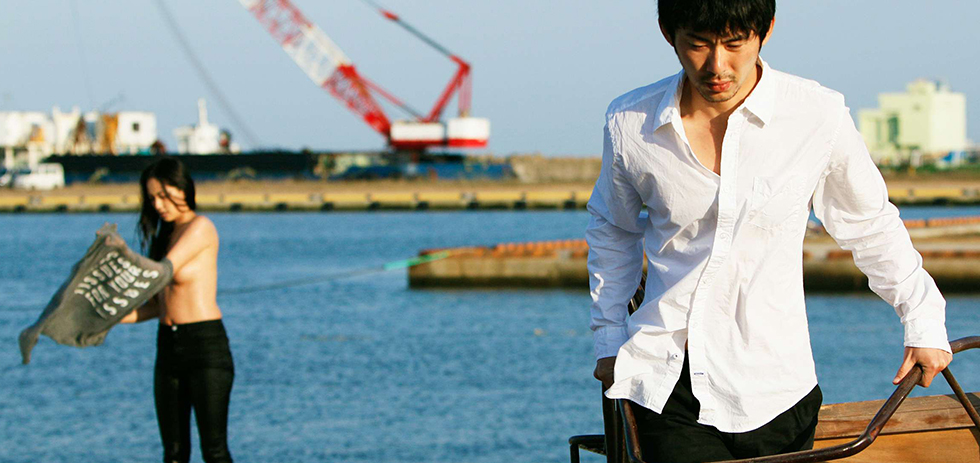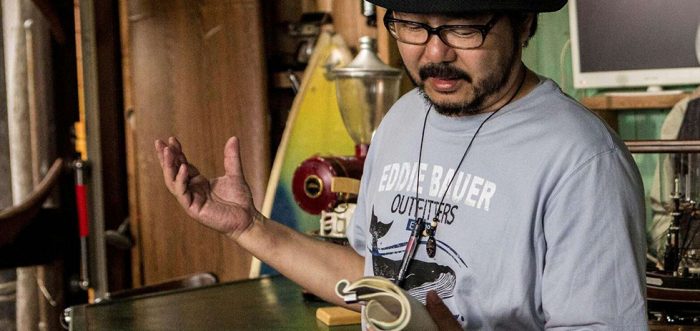Akihiko Shiota has spent a great deal of his time in film exploring interpersonal dynamics, flipping status quos, and playing around with power in relationships. His latest work, Wet Woman in the Wind, which premiered at Locarno Film Festival, continues his interest in these ideas – with the additional context of being part of Nikkatsu’s series of Roman Porno revival films. On paper, a low-budget, pornographic, era-revival film ending up in Locarno’s official competition might seem hard to believe. At the same time, there’s a lot more to Shiota’s film than the genre it works within – although even here his ability to invert and deconstruct it serves as a testament to his strength as a filmmaker. Over the course of our discussion – taking place at Locarno Film Festival – we spoke about the history of the genre, what it means to make a Roman Porno in the 21st century, and the manner in which Shiota approached making one of the festival’s most surprisingly captivating works.
Note: The following interview was conducted with the assistance of an interpreter, Julian Ross. Many thanks to him and Locarno Film Festival for making this interview possible.
I wanted to start by asking about the project. What was behind the project itself with Nikkatsu asking five directors to make modern kind of takes on the ‘Roman Porno’ 1 and how you came in contact with them, and how that whole project came underway?
I had already shot some film with Nikkatsu studio. This includes Moonlight Whispers, and another film called, Harmful Insect… so there was already an established relationship with the studio. These projects actually took place a while ago, but in any case, I know some people there still and I got the offer. When I was initially offered the project, I wasn’t aware of who else was involved. In any case, I thought it was a great opportunity to take part in this interesting project.
I remember after I saw the film, where I went and read up on it. I noticed other big names in modern Japanese cinema like Sion Sono were also involved. They gave you a few kind of guidelines in making the films though. I was curious about what they were? I know that it had to be shorter than eighty minutes, and you had a certain time frame to work within. That said, I wasn’t able to find the specifics in English, so I wanted to know what sort of a structure you had to work within?
It was nothing really complicated, but yeah, it had to be under eighty minutes…
Right –
Every ten minutes or so there had to be a nude scene or some sort of a sex scene. Yeah. The film had to be shot in seven days, and all five directors had to follow these rules. Everybody was working under the same conditions. But I think it was probably just me that followed it completely.

I think the bit that fascinates me the most isn’t just that you followed these guidelines, but that the final product ended up in the Concorcoso Internazionale at Locarno. Was Nikkatsu heavily involved in this or did the interest come from this side? How did Wet Woman in the Wind make that jump from being a studio project to premiering at such a particular and lauded festival.
Yeah, I am surprised myself, so it is hard for me to explain. In any case, this was a low budget film. I did have to follow some guidelines and rules that Nikkatsu provided me with. In a sense the Nikkatsu producers invited filmmakers that he or she likes, and asked for them to make a film in a way that they liked themselves. In that sense, we were provided with quite a bit of freedom. And in that sense, the Nikkatsu producers stood by the directors. They were very supportive of whatever we wanted to come up with and make ourselves. Everything I came up with I put down on paper actually in seven days, so the script is also written in a week. After a while, suddenly I realised I’m here now.
I know in an interview I did with Sion Sono this time last year he was talking about how he felt really comfortable working at a fast pace; how he wanted to view cinema as music and have films coming out as much as say, a recording artist would release songs. Looking at your creative releases, you definitely release films less frequently than someone like Sono, but you were able to make this in 7 days. Was it difficult coming up with an idea that quickly, and bringing it to fruition at such a pace?
Just like Sono Sion and Takashi Miike, I would like to make projects at a fast pace… As frequently as they do. But I personally don’t have the energy to dedicate, to shoulder everything, to make such a project.
Alright –
There are gaps between projects, but when I am in a project, I am fully committed and working at a fast pace. That’s how I work. In the past years I’ve been working on my scripts at such a fast pace, and that’s actually a very interesting method for me. Because naturally I start coming up with the sort of unconventional way of storytelling because of the pace that I am writing within. A sort of broken way of storytelling. That’s very interesting for me, so it’s been productive.

You’ve filmed quite particular sexual relationships in your films before. I remember in Moonlight Whispers, you had this kind of dynamic with a girl flipping this boy’s fetishes back on him and kind of exploiting him throughout the film in quite weird and funny ways. I wanted to know what kind of draws you to those kind of subjects and dynamics – and whether that background in writing stories such as Moonlight Whispers helped with the dynamic in Wet Woman in the Wind?
I think there are many reasons for this. One that I can mention is that, to shoot with freedom, it often means you have to make works at a low budget. For that to take place I often try and come up with ideas that only involve one or two characters. This is something that Rossellini did, this is something that John Cassavetes did, and it’s one way I try to do this. Another reason is that when you’re depicting human relationships you can go the emotional route, and at times when you do put into play sort of power relationships, one is an authoritative figure that’s in some way manipulative… things like S&M sort of relationships. These on the one hand are sort of personal and intimate stories between two people, but on the other hand they can sort of broaden the perspective through this sort of microcosm to bring in societal issues. And suddenly a small story becomes something that speaks of an entire society and how it functions. So that’s another reason.
While a lot of the film is very funny, humorous. From about maybe halfway through the film until the end, I remember the whole theatre was laughing almost non-stop. At the same time, I’m interested in kind of the other side of what you also feel a film that does express all these things through comedy, what it can actually can also say on another level about sex and society, and taboo, and desire, and the fantasies of the main character – and within all of that, I wanted to know how you view a film like this.
Well, that’s a difficult question. The one thing I could say is that in the Seventies and Eighties, Nikkatsu Roman Porno existed and they made films, and one difference between those films and my one now is that the females characters are strong characters. Perhaps even the strongest. And that’s a characteristic that differentiates my work to the ones that were made in the seventies.
In the review I wrote of the film that was one of things I noted, that it kind of flips that dynamic. One of the things interesting about the way in which the Seventies Roman Porno functioned is that it had a kind of political element in being a protest against censorship at the time, and a lot of the directors involved, like Adachi Masao, who left the country in exile for like 20 years. Obviously that’s kind of an extreme end of it. But I’m interested in what you think a Roman Porno functions today in Japan, since censorship laws have changed?
It’s great that you know Adachi Masao. But actually, to be accurate, Adachi and Wakamatsu and the people surrounding them were not involved in Roman Porno with Nikkatsu Studio. They were Pink filmmakers 2 with even lower budgets. But within that group there was a figure called Atsushi Yamatoya3, who’s actually the mentor for screenwriting for me. He was a mentor of mine. So looking back at the 1960s, indeed there was a level of these works going against the mainstream politics and in a sense sexual emancipation had political meaning. Freedom of expression, more broadly, was directly connected with politics. I don’t think that’s necessarily operating at the same level now, in this day and age. For example, today you can just go online and find any sort of adult videos and see anything. So in that sense what Nikkatsu Roman Porno are doing now doesn’t have the same impact in the same way regarding this particular topic.
So what does it mean to make a Roman Porno work now? I don’t think it has the same sort of societal impact that these works used to have back in the day. Perhaps we can understand it more as a sort of parody of what happened back then. Because in this day and age, when you have complete access to any sort of hardcore pornography for you own personal enjoyment, we are making softcore porn. So when reflecting back on the sort of political and societal impacts these works once had, back in the day, and making my own version of it today, it sort of came naturally to me to make a sort of comedy.

I think it works really well on that level as well. From my perspective, I saw it kind of looking back at the genre and taking something like the power positions of the male and female characters and flipping that quite a bit, even if elements of the genre still make that dynamic a bit uneasy at times. I think that it’s kind of looking back at the genre, not only at being a comedy, but also seeing a way to make it more relevant to today, which I thought was interesting.
So, again, why is Nikkatsu making Roman Porno works now? Well, this also speaks of the current situation of the film world in Japan. Most of the money is going to big budget films and commercial films, and these smaller works, for theatres and also film festival circuits … The budget for these works are getting smaller and smaller. So there’s less and less opportunity for auteur-driven films to be made within this framework. It’s a pretty dire situation in Japan right now, concerning that. On top of this, there’s not many opportunities for funding these films in state-sponsored ways either, so it’s hard to find the budget to put together these works. By placing this sort of genre parameter onto these new works, Nikkatsu are able to make our movies. This is their way of supporting this type of filmmaking and flipping that. What’s interesting for that is that they’re doing something in this day and age that is sort of a rebellious act to the current situation in filmmaking.
It seems kind of cyclical with what was happening in the Sixties and Seventies, with a lot of art house and auteur directors taking that route to work with studios with low budgets to get a name going through festival circuits and stuff – with studios struggling today returning to that form in an interesting sort of way.
When I read afterwards how quickly your film was shot, and the low budget it was shot on, I was genuinely surprised. While there are definitely low budget directors in Japan where that aesthetic comes through, I didn’t feel it was noticeable in Wet Woman in the Wind. I was surprised because every image was composed really well, with very coherent framing. I thought the way in which nature was shot against the characters was also quite beautiful in a way. So yeah, I was interested in whether you had a certain kind of vision with the cinematography or if it kind of worked out looking as it did?
That’s a very nice question. Normally in my past works when I work as a screenwriter and am preparing the film, the image that I have in mind comes first, and then the actors and their performance comes next. And they sort of follow that image. That’s how it usually takes place, but for this this film I decided to reject that notion. I consciously rejected it, and stopped that, and decided to follow it in a different way. So what I did instead was that I took some time for rehearsal with the actors, separate from the shooting schedule and scene by scene went through the scenes with them and collaborated with them on a stronger basis. So that was the basis for all the image making, but on location we also considered the movement and things like it on a more sort of instinctual basis. I guess I’ve built up some experience now for film shooting, so I relied on my instincts.
I said this in my introduction last night, but there was a famous ceramic artist in Japan and when he makes a plate or any ceramic object, he takes three seconds to design it. One journalist interrogated him on it and complained, saying, “If it’s a work that takes so little time to make, why are you selling it for such a high price? You should sell it for cheaper.” The ceramic artist responded, “This work is not made in three seconds. It has taken 20 years of research and effort, plus the three seconds. So it was a work made in twenty years and three seconds. That’s how you should see this ceramic object.” Similarly, I also feel that my film has taken twenty years of research and seven days to write. It has taken twenty years of research and seven days to shoot.
I think that’s the perfect way to put it. Have you seen the other films that the other directors on the project have made? Do you have a favorite? And – sorry, by the way for the trip-barrel question – what do you plan on doing next?
I have not seen the other films yet, and I have no clue about the details of the projects either. This was something I consciously decided to do, because for now I didn’t want to hear what was happening. Of course, I want my project to be the best, but that’s something for the audience to decide. It’s not for me to say. There are a number of works of my own that are currently in the making, but they are in various stages so I cannot really share any details at this stage. One thing I’m quite sure of is that it will be another low-budget film.
Perfect. Considering this was a low budget film and I really enjoyed it, I’m excited for that.
It didn’t feel like a low budget film to you?
Not really, no. I feel like after this conversation I can see how the scope reflects a low budget, but in the way it was shot and the way you worked with this budget, I think it’s really hard to tell because of how beautiful and crisp the whole film looks. Anyway, thank you so much for the interview and best of luck with the film.
Thank you very much. Nice to meet you.
